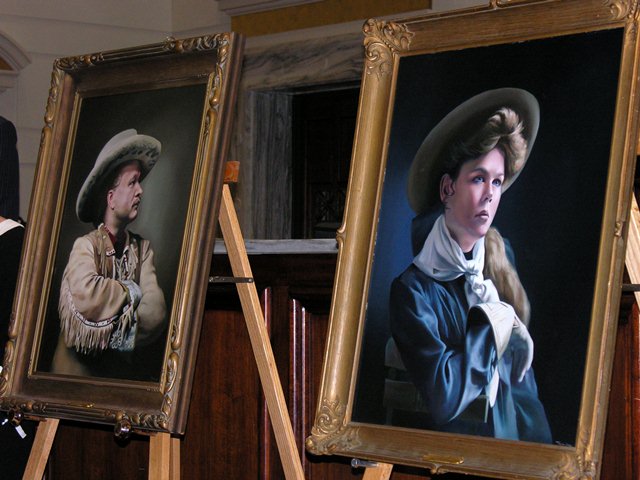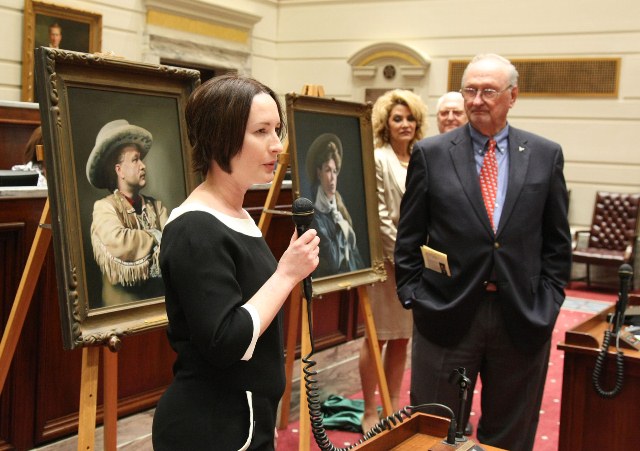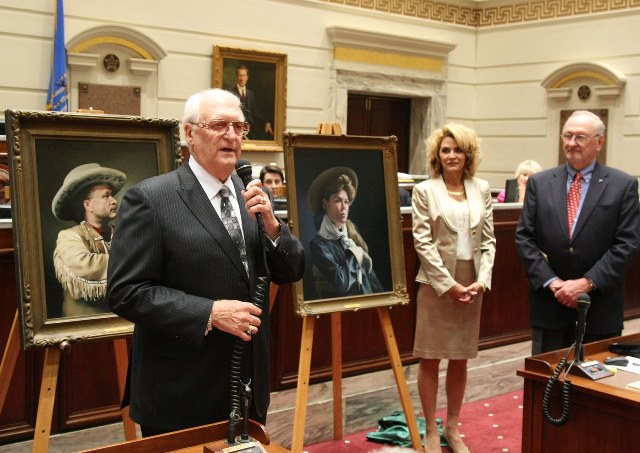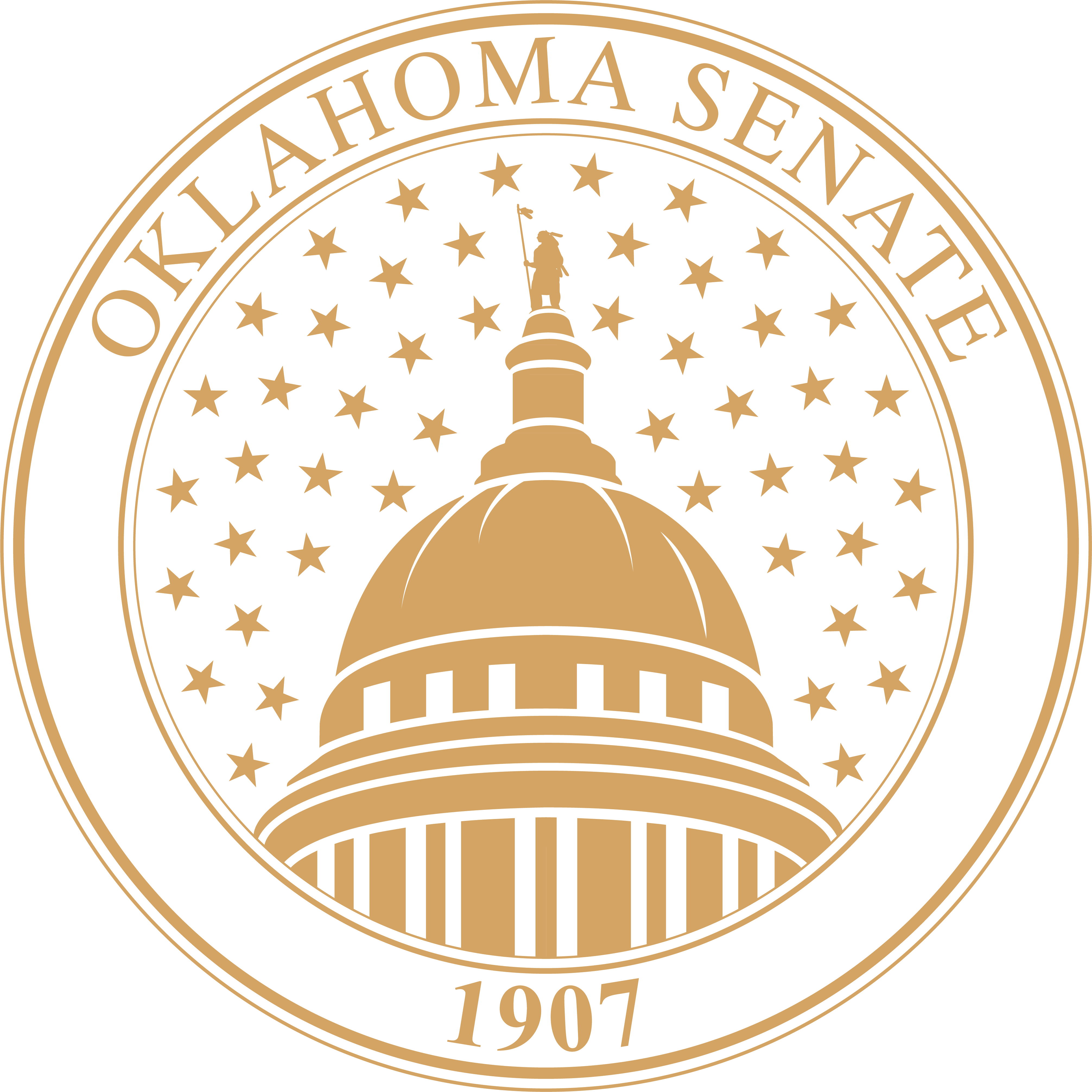In order to provide equal access and equal opportunity to people with diverse abilities, this site has been designed with accessibility in mind. Click here to view
Senate unveils portraits of Wild West show personalities
 Portraits of Oklahoma's most famous Wild West show personalities, Gordon "Pawnee Bill" LIllie and Lucille Mulhall were unveiled Monday in the Senate.
Portraits of Oklahoma's most famous Wild West show personalities, Gordon "Pawnee Bill" LIllie and Lucille Mulhall were unveiled Monday in the Senate.
 Artist Tracey Harris addresses the Senate.
Artist Tracey Harris addresses the Senate.
 Portraits' sponsor Bob Funk thanks Charles Ford and the Senate Preservation Fund for capturing Oklahoma's proud Western heritage.
Portraits' sponsor Bob Funk thanks Charles Ford and the Senate Preservation Fund for capturing Oklahoma's proud Western heritage.
On Monday, the Senate added two more paintings to its diverse collection of artwork depicting famous Oklahomans and special events in the state’s history. The newest additions depict two of Oklahoma’s most famous Wild West Show personalities, Gordon “Pawnee Bill” Lillie and Lucille Mulhall.
The portraits, by Tulsa artist Tracey Harris, were sponsored by Bob Funk and commissioned by the State Senate Historical Preservation Fund, Inc.
World-renowned Wild West showman Gordon “Pawnee Bill” Lillie was born in February 1860 in Bloomington, Illinois but the family later moved near Wellington, Kansas, after their flour mill burned down. There in 1875, Lillie started his life-long relationship with the Pawnee people, who were wintering in the area during their removal to the vicinity of Pawnee, Oklahoma.
Lillie made his way into Indian Territory while working as a trapper with “Trapper Tom” McClain’s outfit, waiting tables, and working as a cowboy. He served as a teacher at the Pawnee agency and was also appointed as interpreter and secretary to Maj. Edward Bowman, U.S. Indian Agent. During this time, he became known as “Pawnee Bill.”
In 1883, he was recruited to help coordinate the efforts of the Pawnee troupe in the first-ever Buffalo Bill Cody’s Wild West show. In 1888, after persuasion from his in-laws, he began touring the country with “Pawnee Bill’s Wild West”, but the show proved to be a financial failure.
However, that same year, Pawnee Bill was named leader of the Boomer Movement, a group dedicated to the opening of Oklahoma’s Unassigned Lands to white settlement. He led a group of 4,000 in the Land Run of April 22, 1889, into the center of present Kingfisher County. This gained him national attention and he reestablished a successful Wild West show called “Pawnee Bill’s Historical Wild West, Indian Museum and Encampment,” which traveled the U.S. and Europe, starring his wife May Lillie as the Champion Horseback Shot of the West.
In 1908, Lucille Mulhall joined forces with Buffalo Bill’s Wild West and Pawnee Bill’s Great Far East,” a Wild West show that had no equal at that time. Legend has it that Roosevelt told her if she could rope a wolf, he would invite her to his inaugural parade. She brought him one three hours later.
She was among the first women to compete in roping and riding events against men and earned such titles as “Champion Lady Steer Roper of the World” at the Winnipeg Stampede. She starred in Mulhall’s Wild West show, the Miller Brothers’ 101 Ranch Wild West show, and in vaudeville. In 1913, she formed her own troupe and in 1916 produced her own rodeo, Lucille Mulhall’s Roundup. She retired around 1922 to the family ranch in Mulhall. She was killed in a car accident on December 22, 1940.
Raised in Fort Gibson, Harris is an emerging artist specializing in contemporary representational painting. She has exhibited internationally and nationally winning numerous awards. After completing her Bachelor’s degree at the Kansas City Art Institute, she moved to London, England to study painting where she received her Master’s degree in visual arts. She has taught Art History, Drawing and has work in the collections of several national collectors. She now lives and paints in the Tulsa area.
This and other art commissioned by the Oklahoma State Senate Historical Preservation Fund can be found on the Internet at www.oksenate.gov under “Senate Artwork”.
 Oklahoma Senate
Oklahoma Senate

